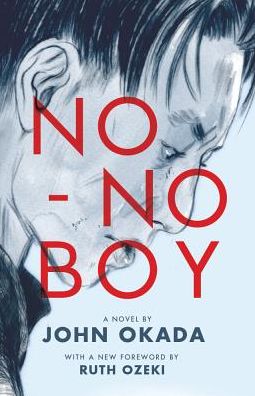I have two big shout-outs/thanks in this post. First, for Adam over at Memento Mori. As soon as he mentioned No-No Boy in one of his videos, I realized that I had never read anything about the Japanese internment camps. I think we had a copy of Baseball Saved Us somewhere in the house, but I want to say it was my brother’s (baseball fan that he is) and not mine. I might have never even read it and just remember the cover.
The second shout-out and thanks go to my friend Henny (of Dirt Nap Podcast fame), who was kind enough send me a huge dump of ebooks from my Goodreads “to-read” shelf, including . . . No-No Boy!
Author: John Okada
My GoodReads rating: 5 stars
Average GoodReads rating: 3.73 stars
Language scaling: B2+
Plot summary: No-No Boy is the story of Ichiro Yamada, a no-no boy who comes back to his life in Seattle after his prison sentence. His mother is proud of him for being a no-no boy; she thinks Japan actually won the war, and that soon she and other loyal Japanese will get to go back. Others are, unsurprisingly, furious with Ichiro, white and Nisei alike. Eventually Ichiro runs into Kenji, a fellow Nisei and a veteran who lost his leg in the European theater and who is only getting more and more ill. Kenji seems to understand Ichiro, at least better than anyone else does, and the two spend a lot of time together as Ichiro tries to figure out his new place in the world.
Content warning: Okada writes about the racial tensions going in post-WWII America, so dialogue can include terms that have since fallen out of favor (or flat-out racial slurs).
Recommended audience: Those interested in post-WWII American history or teaching/studying it in school; those interested in Asian-American authors; those who enjoyed George Takei’s stage show Allegiance.

In-depth thoughts: The title No-No Boy refers to the loyalty questionnaire Nisei Americans (American-born Japanese) were required to answer, as a de facto test of patriotism/”Americanness.” The last two were real humdingers:
Question 27: Are you willing to serve in the armed forces of the United States on combat duty, wherever ordered?
Question 28: Will you swear unqualified allegiances to the United States of America and faithfully defend the United States from any and all attack by foreign or domestic forces, and forswear any form of allegiance or obedience to the Japanese emperor, or other foreign government, power or organization?
Not until the bus had traversed the business district and pointed itself toward the northeast did he realize that he was on the same bus which he used to take every morning as a university student. There had been such a time and he vividly brought to mind, with a hunger that he would never lose, the weighty volumes which he had carried against his side that the cloth of his pants became thin and frayed, and the sandwiches in a brown grocery bag and the slide rule with the leather case which hung from his belt like the sword of learning which it was, for he was going to become an engineer and it had not mattered that Japan would soon be at war with America. To be a student in America was a wonderful thing. To be a student in America studying engineering was a beautiful life. That, in itself, was worth defending from anyone and anything which dared to threaten it with change or extinction. Where was the slide rule, he asked himself, where was the shaft of exacting and thrilling discovery when I need it most? If only I had pictured it and felt it in my hands, I might well have made the right decision, for the seeing and feeling of it would have pushed out the bitterness with the greenness of the grass on the campus and the hardness of the chairs in the airy classrooms with the blackboards stretched wall-to-wall behind the professor, and the books and the sandwiches and the bus rides coming and going. I would have gone into the army for that and I would have shot and killed, and shot and killed some more, because I was happy when I was a student with the finely calculated white sword at my side. But I did not remember or I could not remember because, when one is born in America and learning to love it more and more every day without thinking it, it is not an easy thing to discover suddenly that being American is a terribly incomplete thing if one’s face is not white and one’s parents are Japanese of the country Japan which attacked America. It is like being pulled asunder by a whirling tornado and one does not think of a slide rule though that may be the thing which will save one.
I hope that whet your appetite! If you’ve read No-No Boy, I’m curious about what you think. If not (or even if you have, I guess), what are some other under-read and underappreciated classics that you think should be more famous? Why?
